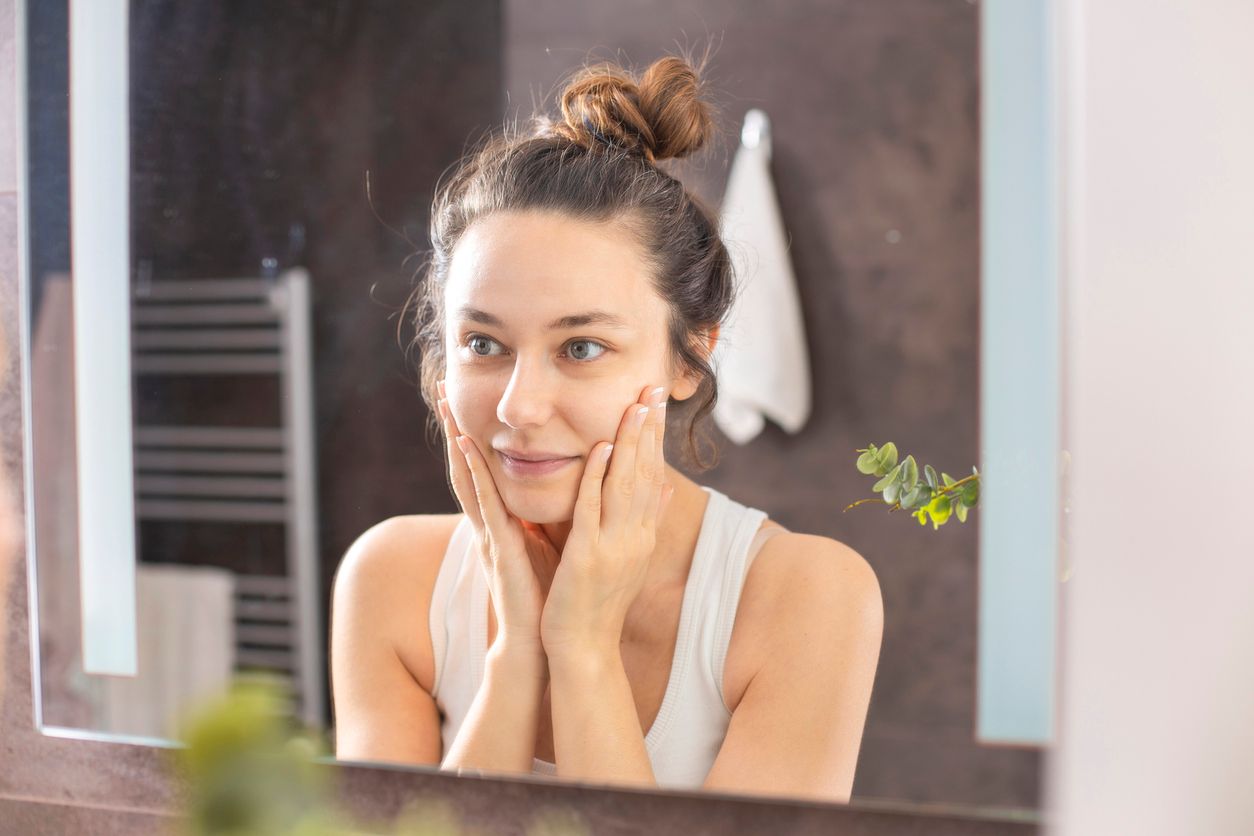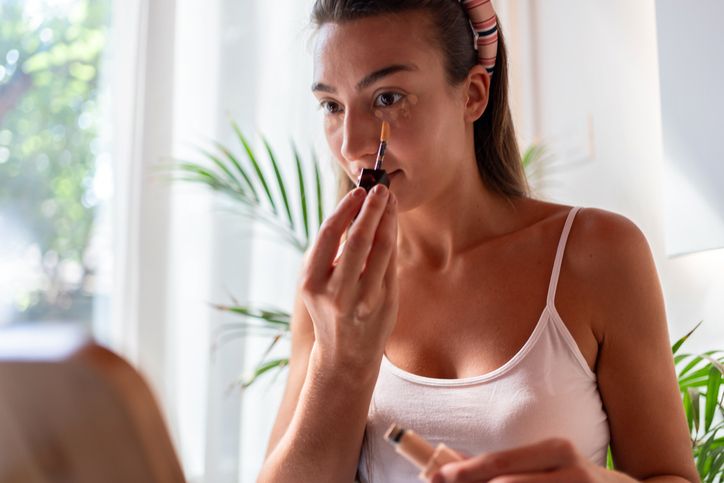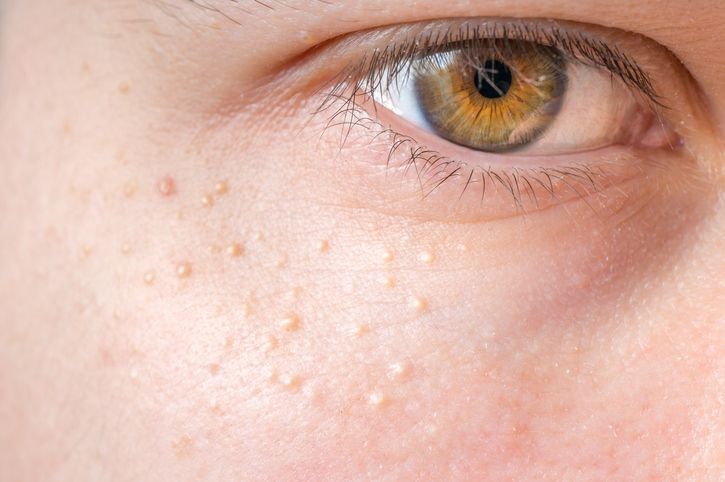- Home
- Trend
- Weight Loss Strategies
- Acne Tips
- Hair Health Information
- Blemish Removal Tips
- Acne Scar Removal Tips
- Muscle Building Techniques
- Intimate Care Tips
- Postpartum Intimate Care
- Eye Bags Wiki
- Tips for Face Slimming
- Secret of Permanent Hair Removal
- Breast Enlargement Tips
- Cure to Snoring
- Marionette Lines
- Skin-Tightening Secrets
Facial symmetry has long been associated with beauty, as balanced features are often perceived as more harmonious and aesthetically pleasing. While some degree of asymmetry is natural in every face, noticeable imbalances can cause concern, particularly when they affect one's confidence or overall appearance. Let's explore 6 common reasons behind an asymmetrical face, as well as insights into solutions that enhance facial harmony and balance.
6 Key Indicators of an Asymmetrical Face

An asymmetrical face is when the right and left sides of a person’s face appear noticeably different. While human faces naturally exhibit minor facial asymmetry due to genetic variation, natural aging, or lifestyle factors, an asymmetrical face refers to imbalances that are more visible or pronounced. These imbalances can affect the facial features, such as the eyes, nose, lips, jawline, or even the overall facial structure.
1. Facial Midline Shift
A facial midline shift occurs when the vertical centerline of the face does not align evenly with key features such as the nose, lips, and chin. The main causes of this misalignment include:
Dental Changes: Misaligned teeth or uneven jaw growth can push the midline off-center. Also, chewing food on just one side of the mouth can lead to uneven wear on the jawline, affecting the facial midline and creating asymmetrical features.
Skeletal Structure Issues: Discrepancies in the development of the jaw or other craniofacial bones can create asymmetry. An uneven jawline affects the lower face's symmetry and balance. Uneven growth of the jawbones or congenital conditions like a cleft lip can lead to asymmetry. Also, changes in the alignment of teeth can shift the jawline, creating a lopsided midline appearance.
Postural Habits: Consistently sleeping on one side compresses the facial muscles and softens the facial structure over time. Similarly, poor posture, especially from prolonged smartphone use, causes the right and left sides of the face to develop unevenly, as muscles on the opposite side compensate for the imbalance.
2. Uneven Eye Level
Uneven eyes, where one eye appears higher, larger, or differently shaped than the other, can result from several factors:
Facial Trauma: Facial trauma, including injuries to the soft tissues or bones around the eyes, is one of the leading causes of uneven eyes. For example, a blow to the face can damage the orbital bones or the muscles controlling eye movement, leading to shifts in the positioning or shape of the eyes.
Bell’s Palsy or Other Conditions: Bell’s Palsy is a condition that causes temporary facial paralysis, often affecting one side of the face. This can result in drooping or unevenness around the eyes, with one eye appearing smaller or lower than the other. In addition to Bell’s Palsy, other neurological conditions or facial nerve damage can lead to similar symptoms.
Aging or Lifestyle Factors: As we age, the skin naturally loses elasticity, and the underlying tissues undergo gradual changes. These age-related factors can cause the eyelids to sag, leading to one eye appearing more droopy or lower than the other. Additionally, the loss of volume in the soft tissue around the eyes can make one eye appear hollow or sunken, exacerbating the asymmetry.
3. Nose or Chin Misalignment
The nose and chin are central to facial harmony, and their misalignment can result from the following:
Trauma or Injury: A broken nose is one of the most common causes of nasal asymmetry. The force of an impact can cause the nasal bones to shift, leading to a crooked nose or a noticeable tilt. Similarly, damage to the soft tissue or bones of the chin can cause the chin to appear misaligned or recede on one side
Skeletal Structure Irregularities: Genetic predispositions or developmental issues can lead to a naturally slanted nose or receding chin. For example, a slanted nose or a receding chin may be due to genetic predispositions or developmental issues during growth.
Aging and Skin Changes: The skin around the nose and chin may begin to sag due to a reduction in collagen production, leading to a drooping or misaligned appearance. In the case of the chin, excess skin and the gradual loss of bone density in the jawline can cause the chin to appear recessed or less defined.
4. Differing Cheekbone Heights
Uneven cheekbone heights disrupt facial contours and may result from:
Craniofacial Asymmetry: During childhood or adolescence, the bones of the face grow at different rates, and this can result in uneven facial features, including cheekbones. If one cheekbone develops more prominently than the other, it can create a noticeable asymmetry called craniofacial asymmetry in the middle of the face.
Aging-Related Changes: Collagen loss is usually most noticeable on cheeks. With time, skin laxity causes sagging, and as the tissue around one cheekbone becomes looser, it can appear less defined than the other. Additionally, the fat pads that provide volume to the cheeks begin to shrink, further accentuating the differences in cheekbone height.
Facial Trauma: Facial trauma, such as accidents or injuries, can have a lasting impact on the structure of the face. The cheekbones, being a prominent feature of the face, are especially susceptible to fractures and injuries. A broken cheekbone, or zygomatic fracture, may cause one side of the face to appear lower or more sunken compared to the other. The healing process following such trauma can result in permanent asymmetries due to the misalignment of the fractured bone or the formation of scar tissue.
5. Lip Discrepancies
Differences in the height or starting point of the lips can result in asymmetry. Common causes include:
Weakened Facial Muscles: As with other facial features, weakened facial muscles are often due to conditions like the medical condition mentioned above (Bell’s Palsy), which can affect lip symmetry. When the muscles controlling the lips are compromised, it can lead to a drooping or uneven appearance, with one side of the lips lacking full mobility.
Habitual Behaviors: Repeated facial expressions or habitual behaviors, such as resting on one side of the face, can also influence lip alignment over time. Consistently using one side of the face more than the other can subtly shift the muscles and soft tissues around the lips, contributing to unevenness.
Aging: Aging will also make the skin around the mouth begin to lose its elasticity, and the tissues may sag or lose volume. The muscles that support the lips get weakened over time too, which can lead to more noticeable discrepancies in lip alignment.
Normal vs. Noticeable Asymmetry
While most healthy subjects have slight asymmetries due to natural variations in skeletal structure, muscle tone, or even dental changes, some individuals experience noticeable asymmetry. This can be caused by factors like facial trauma, health conditions (e.g., Bell’s Palsy), or lifestyle habits (e.g., sleeping on one side).
An asymmetrical face may be perceived as a concern when it affects a person’s confidence, impacts facial aesthetics, or creates functional issues like difficulty chewing, speaking, or blinking.
How to Check If You Have Facial Asymmetry at Home?

To assess if you have facial asymmetry on your own, you can follow these steps to self-measure and observe key facial features. Remember, most people have minor asymmetry, but significant imbalances may require professional evaluation for a more accurate diagnosis.
Facial Midline Alignment
Stand in front of a mirror and observe the imaginary vertical line that runs from the center of your forehead down to the tip of your chin (the facial midline). This line should ideally split the face into two equal halves.
What to Look For: Check if your nose, lips, and chin align symmetrically with this midline. If one side of your nose, lips, or chin shifts to one side, it could indicate facial asymmetry.
Eye Level and Shape
Using a ruler or a printed photo of your face, check if both eyes are at the same level. One eye may appear higher or lower than the other.
What to Look For: Stand straight and use the ruler to draw a line horizontally through both eye centers. If the line is not level, there may be uneven eye positioning. Also, notice if one eye appears larger or more open than the other.
Nose and Chin Alignment
Stand in front of a mirror and carefully examine the straightness of your nose and chin when viewed from the front.
What to Look For: A misaligned or slanted nose or a chin that appears to be tilted or shifted can be signs of facial asymmetry. You can also compare the distance between the tip of your nose and your chin on both sides of the face.
Cheekbone Height
Check the height and prominence of your cheekbones by feeling or lightly pressing on both sides of your face.
What to Look For: If one cheekbone is noticeably higher or more pronounced than the other, this could indicate asymmetry. Take note if this imbalance affects the contour of your face.
Lip Symmetry
Examine the symmetry of your lips by observing the corners and the lines where your lips begin (upper and lower).
What to Look For: If one side of the lips begins higher or lower than the other or if one side is fuller or thinner, this could indicate lip asymmetry.
Jawline and Chin
Stand straight and observe the alignment of your jawline from the front. You can also feel the edges of your jaw and check if one side feels more pronounced than the other.
What to Look For: A receding chin or an uneven jawline that shifts to one side can signal an imbalance in the lower part of your face.
Take a Printed Photo
To get an accurate view, take a clear printed photo of yourself facing directly forward and another with your head turned slightly to the side.
What to Look For: Compare the symmetry of your features in both images. This will help you notice any imbalances in your face that might not be as obvious in the mirror.
免費體驗
Ultra V Lift Pro Non-Surgical Instant Facelift Treatment
1 Minute Self-Registration
Date should not be before minimal date
Ultra V Lift Pro Non-Surgical Instant Facelift Treatment: Tackling Your Facial Asymmetry
When it comes to improving facial symmetry, the Ultra V Lift Pro Non-Surgical Instant Facelift Treatment offers an advanced, non-invasive solution. Utilizing the patented TDT™ Thermal Diffusion Tightening technology, this treatment directly targets key areas of concern, helping to restore balance and enhance facial harmony. Here’s how it addresses some common asymmetrical problems:
Correcting Facial Midline Shifts
Facial midline shifts, caused by uneven muscle tension or skeletal discrepancies, can be minimized with the Ultra V Lift Pro. By evenly distributing ultrasonic energy into the deeper layers of the skin, the treatment stimulates collagen production and gently lifts sagging areas. This rebalancing effect aligns the facial features more symmetrically along the midline.
Balancing Uneven Eye Levels
Uneven eye levels, often influenced by weakened facial muscles or skin laxity, can benefit from this treatment's ability to firm and tighten delicate skin. The precise energy application around the upper and lower eyelids helps smooth wrinkles and lift droopy areas, creating a more balanced and refreshed eye appearance.
Addressing Nose or Chin Misalignment
Misalignment of the nose or chin can significantly impact facial aesthetics. While the Ultra V Lift Pro is not a substitute for surgical procedures like rhinoplasty or chin implants, it can improve the overall contour by tightening the surrounding soft tissues. This creates a more streamlined and balanced look, especially for individuals with minor irregularities or receding chins.
Enhancing Cheekbone Symmetry
Differences in cheekbone prominence can make the face appear asymmetrical. The Ultra V Lift Pro targets the dermis and SMAS layers, encouraging collagen regeneration and providing a subtle lifting effect. This smooths uneven contours and accentuates natural beauty by balancing the cheekbones’ prominence.
Reducing Lip Discrepancies
When lips appear uneven due to skin laxity or muscle weakness, this treatment can restore symmetry by firming the areas around the mouth. The ultrasonic energy gently stimulates collagen, lifting and tightening the lips' contours for a more proportional appearance.
Refining the Jawline
An uneven jawline caused by sagging skin or a double chin can be effectively treated with the Ultra V Lift Pro. By targeting the subcutaneous layers, the technology tightens loose skin, reshapes the jawline, and reduces noticeable asymmetry. The result is a more defined and balanced lower face.
The Non-Invasive Advantage
Unlike surgical interventions, the Ultra V Lift Pro requires no incisions, downtime, or lengthy recovery periods. It is a safe, painless option for those looking to enhance facial balance without undergoing facial asymmetry surgery. With results that last 1–3 years, this treatment offers long-lasting improvements that promote facial harmony and a youthful appearance.
While some degree of facial asymmetry is a hallmark of human uniqueness, significant imbalances can impact facial aesthetics and confidence. No matter the causes, a combination of preventative care and innovative treatments can help you enhance facial harmony and regain a balanced, youthful appearance. Take the first step towards a more balanced, youthful you—book your consultation today and discover how this treatment can transform your appearance.
Ultra V Lift Pro Non-Surgical Instant Facelift Treatment免費體驗
Ultra V Lift Pro Non-Surgical Instant Facelift Treatment
1 Minute Self-Registration
Date should not be before minimal date
FAQ

1. What are average facial configurations, and how do they relate to facial symmetry?
Average facial configurations refer to the general patterns of facial proportions and alignments considered ideal or typical in a population. These configurations are often used as benchmarks when assessing facial symmetry. Symmetrical faces tend to align with these average proportions, where features like the eyes, nose, and lips are evenly distributed.
2. How can the position where the lips begin impact the appearance of facial asymmetry?
The point where the lips begin plays a significant role in facial symmetry. If one side of the lips begins higher or lower than the other, it can create noticeable asymmetry. This discrepancy can stem from factors like facial trauma, muscle weakness, or even lifestyle habits such as sleeping on one side. A correct diagnosis from a professional is necessary to determine the cause, and a more detailed diagnosis can reveal the underlying factors contributing to the imbalance.
3. Why is a correct diagnosis important for addressing facial asymmetry?
A correct diagnosis is crucial when addressing facial asymmetry because it identifies the root cause of the imbalance, whether it’s related to the skeletal structure, facial muscles, or external factors like health conditions or trauma. A more detailed diagnosis helps in creating a customized treatment plan tailored to the individual's specific needs. For instance, asymmetry caused by facial trauma may require different interventions than one caused by aging-related skin laxity.
4. Can symmetrical faces always be achieved through treatment?
Achieving perfectly symmetrical faces is challenging due to natural variations in individual features, but there are treatments that can significantly improve facial balance and symmetry. Through addressing factors like skin laxity, misaligned features, or muscular imbalances, treatments such as the Ultra V Lift Pro can help create a more harmonious and youthful appearance.
5. What are the potential risks associated with facial symmetry treatments?
Like any cosmetic treatment, facial symmetry treatments come with potential risks. These risks can include bruising, swelling, or temporary discomfort following non-invasive procedures like the Ultra V Lift Pro. In rare cases, more invasive treatments such as facial implants or surgery can lead to complications like infection or asymmetry if not performed by a skilled practitioner.








